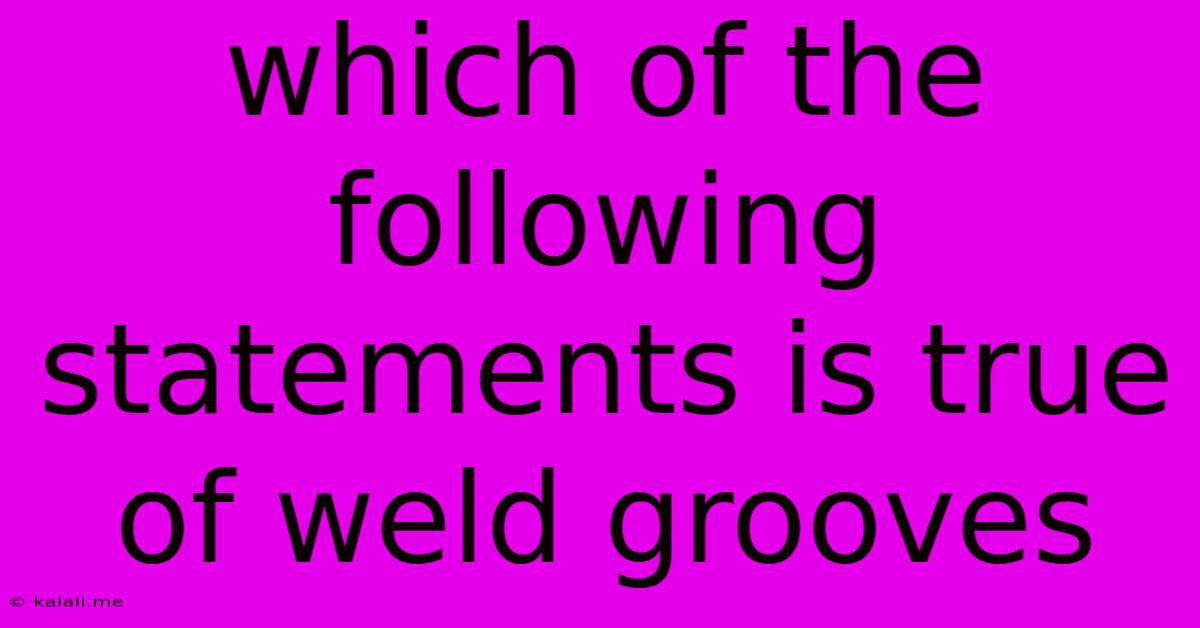Which Of The Following Statements Is True Of Weld Grooves
Kalali
Jun 14, 2025 · 3 min read

Table of Contents
Which of the Following Statements is True of Weld Grooves? A Comprehensive Guide
Meta Description: Understanding weld grooves is crucial for successful welding. This article explores common statements about weld grooves, clarifying truths and misconceptions to improve your welding knowledge. We'll cover different groove designs, their purpose, and their impact on weld quality.
Weld grooves are a critical aspect of welding preparation. The design and preparation of the weld groove significantly impact the strength, quality, and overall success of the weld. Many statements circulate about weld grooves, some accurate, others misleading. This article clarifies common statements to provide a comprehensive understanding.
What is a Weld Groove?
Before diving into true and false statements, let's define a weld groove. A weld groove is the prepared area on the edges of the materials being joined where the weld metal will be deposited. Proper groove design ensures complete penetration, minimizes weld defects, and optimizes the weld's mechanical properties. The type of groove used depends on several factors, including material thickness, weld joint type, and the desired weld strength.
Common Statements About Weld Grooves: Fact or Fiction?
Let's analyze some common statements about weld grooves to determine their accuracy:
Statement 1: All weld grooves require a root opening.
Verdict: False. While many weld grooves do utilize a root opening (the gap between the base materials at the bottom of the groove), this isn't universally true. Some groove designs, particularly those used with thicker materials or specific welding processes, may not require a root opening. For instance, a single-V groove in thick materials might be welded without a root opening, relying on the welding process to fully penetrate the joint. The presence or absence of a root opening depends on the specific groove design and the welding parameters.
Statement 2: The correct weld groove design minimizes weld distortion.
Verdict: True. A well-designed weld groove helps to control heat input and the resulting distortion. By strategically shaping the groove, welders can minimize the concentration of heat in a single area, preventing excessive thermal expansion and contraction that leads to warping or distortion. Proper groove design also contributes to more uniform heat distribution, leading to a more controlled and less distorted weld. This is particularly crucial in situations where dimensional accuracy is paramount.
Statement 3: The groove angle impacts penetration and weld strength.
Verdict: True. The angle of the groove's sides (the bevel angle) directly influences the weld's penetration and consequently its strength. A shallower bevel angle might lead to insufficient penetration, resulting in a weak weld. Conversely, an excessively steep angle can cause undercut or other weld defects. Optimal groove angles are determined by factors like material thickness, weld joint type, and the welding process being employed. Careful consideration of the bevel angle is essential for achieving a strong, reliable weld.
Statement 4: All weld grooves require backing materials.
Verdict: False. Backing materials are often used to support the weld pool, especially in situations involving thin materials or root openings. They prevent weld metal from dripping through and ensure complete penetration. However, many weld groove designs, especially those in thicker materials or with specific welding processes like submerged arc welding (SAW), do not necessitate backing materials. The need for backing materials is contingent on the specific weld design and welding conditions.
Statement 5: Weld groove design affects the choice of welding process.
Verdict: True. The design of the weld groove significantly influences the suitability of different welding processes. Certain processes are better suited to specific groove designs. For instance, Gas Metal Arc Welding (GMAW) might be ideal for a single-V groove, while a double-V groove might be better suited for processes like Shielded Metal Arc Welding (SMAW) depending on material thickness and other considerations. Therefore, the groove design and welding process selection are intricately linked.
Conclusion
Understanding weld grooves is vital for successful welding. Choosing the right groove design, considering factors like material thickness, joint type and desired weld quality, ensures the weld meets the required strength and quality standards. By dispelling misconceptions and focusing on the principles outlined above, welders can greatly improve the quality and reliability of their welds.
Latest Posts
Latest Posts
-
Approximately How Many Elements Occur Naturally On Earth
Jun 15, 2025
-
What Is 10101010 In Decimal Format
Jun 15, 2025
-
Common Multiple Of 28 And 98
Jun 15, 2025
-
Which Of The Following Is Not True Of Organelles
Jun 15, 2025
-
Oxidation State Of C In Ch4
Jun 15, 2025
Related Post
Thank you for visiting our website which covers about Which Of The Following Statements Is True Of Weld Grooves . We hope the information provided has been useful to you. Feel free to contact us if you have any questions or need further assistance. See you next time and don't miss to bookmark.